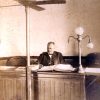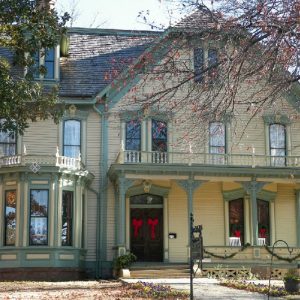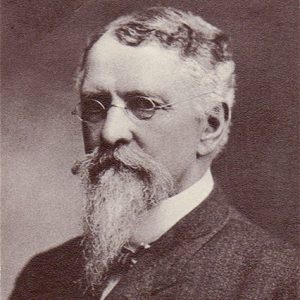calsfoundation@cals.org
William Henry Harrison Clayton (1840–1920)
William H. H. Clayton moved to Arkansas in 1864 and like his brothers, Powell Clayton and John Middleton Clayton, he was an important figure in the history of the state during Reconstruction. Most notably, he held the position of district attorney for the Western District of Arkansas. His home in Fort Smith (Sebastian County) was made into a museum.
William Henry Harrison Clayton and his twin brother, John Middleton Clayton, were born on October 13, 1840, in Delaware County, Pennsylvania. Their parents, John and Ann Clayton, named the boys after the Whig presidential candidates William Henry Harrison and John Tyler. The twins, along with their older brothers, Thomas and Powell, lived on the family farm and received their education at a local school. In 1859, Clayton began studying at the Village Creek Seminary in Delaware County.
With the outbreak of the Civil War, Clayton left school and organized a volunteer company. On August 15, 1862, the U.S. Army mustered him into Company H of the 124th Pennsylvania Infantry as a second lieutenant. He fought in the battles of Antietam, Fredericksburg, and Chancellorsville. Clayton left the army in May 1863, with the disbandment of his company. He returned to Pennsylvania and taught military tactics at a school until the fall of 1864.
In the winter of 1864, Clayton joined his brother Powell in Pine Bluff (Jefferson County). The brothers leased a planation and made enough money to purchase a 2,400-acre farm near Pine Bluff. In 1868, Clayton sold his shares of the land and moved to Huntsville (Madison County) to study law under Judge Stephenson. While pursuing his studies, Clayton took on the duties of assistant assessor of internal revenue. Later that year, Powell Clayton, the newly elected Republican governor of Arkansas, appointed his brother as the superintendent of public instruction for the Seventh Judicial Circuit. In 1870, he became a trustee of Arkansas Industrial University, now the University of Arkansas (UA) in Fayetteville (Washington County).
On October 13, 1869, Clayton married Florence Alabama Barnes, a Pine Bluff native. The couple had eight children, one of whom died.
Judge Stephenson admitted Clayton to the bar in 1871, and on March 23, he became the district attorney for the First Judicial Circuit of Arkansas. After an appointment by Governor Elisha Baxter, Clayton served as the judge for the same district from April 1873 to July 1874. In August 1874, President Ulysses S. Grant appointed him the district attorney for the Western District of Arkansas and Indian Territory. In his new position, Clayton worked closely with Judge Isaac Parker. Clayton held the appointment of district attorney from 1875 to 1885 and again from 1889 to 1893.
Clayton was an active member of the Fort Smith community. He held membership with the local Masonic lodge and served as Grand Master and Grand Commander of the Knights Templar in Arkansas. In 1882, Clayton bought and remodeled a house in the Italianate style. The house was constructed around an existing structure built in 1852.
In 1897, President William McKinley appointed Clayton the judge of the Central District of Indian Territory (present-day Oklahoma) in McAlister. From 1901 to 1907, he served as the senior judge of the federal courts and chief justice of the U.S. Court of Appeals in Indian Territory. In 1907, Clayton opened a private law practice with his son. He died on December 14, 1920, at the age of eighty in McAlister, Oklahoma. He is buried at the Fort Smith National Cemetery.
In 1965, a group of Fort Smith citizens began a revitalization project in an effort to stop the city from demolishing its historic structures. One of the structures saved from demolition belonged to William Clayton. Today, the Fort Smith Heritage Foundation operates the Clayton House as Fort Smith’s only Victorian house museum.
For additional information:
Bearss, Edwin C., and Arrell Morgan Gibson. Fort Smith: Little Gibraltar on the Arkansas. Norman: University of Oklahoma Press, 1979.
Bynum, Samantha. “Frontier Homestead to Victorian House Museum: The William H. H. Clayton House.” MA thesis, Arkansas Tech University, 2014.
Clayton House. http://www.claytonhouse.org/ (accessed June 22, 2017).
Spear, William S., and John Henry Brown. The Encyclopedia of the New West: Containing Fully Authenticated Information of the Agricultural, Mercantile, Commercial, Manufacturing, Mining and Grazing Resources and Present Condition of Texas, Arkansas, Colorado, New Mexico, and Indian Territory. Marshall, TX: The United States Biographical Publishing Company, 1881.
Samantha Bynum
El Dorado, Arkansas
 Law
Law Post-Reconstruction through the Gilded Age, 1875 through 1900
Post-Reconstruction through the Gilded Age, 1875 through 1900 William H. H. Clayton House
William H. H. Clayton House  William H. H. Clayton
William H. H. Clayton 



Comments
No comments on this entry yet.